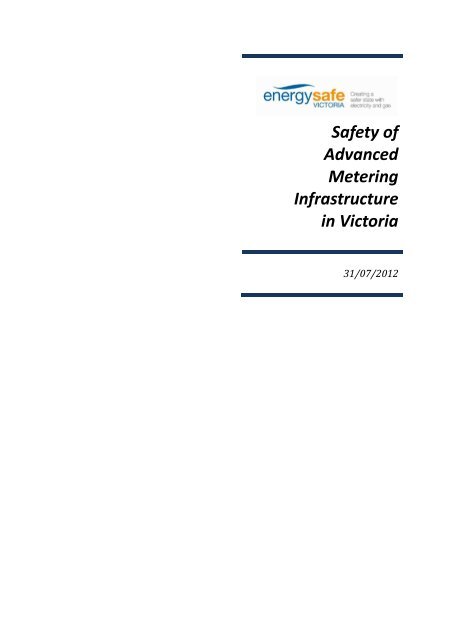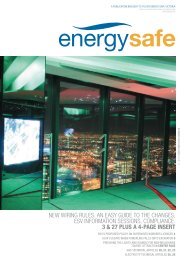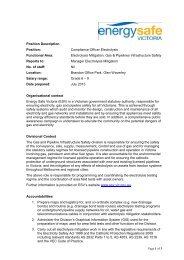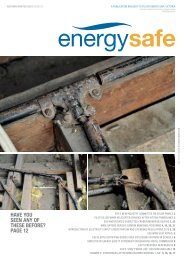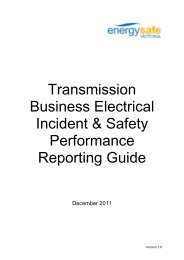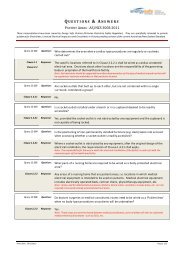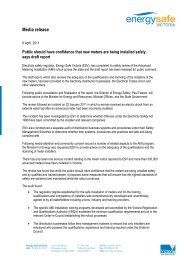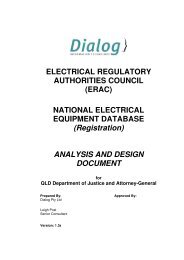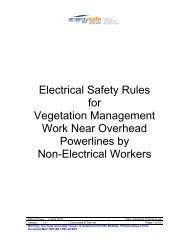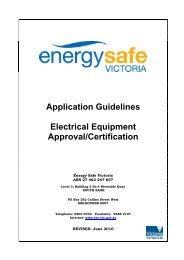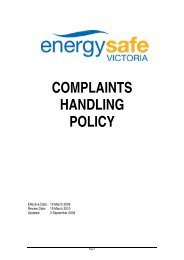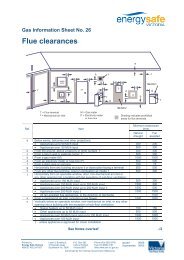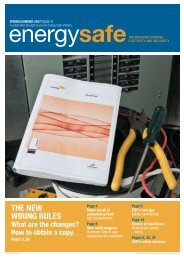FINAL ESV smart meter safety report 31 7 12 - Energy Safe Victoria
FINAL ESV smart meter safety report 31 7 12 - Energy Safe Victoria
FINAL ESV smart meter safety report 31 7 12 - Energy Safe Victoria
You also want an ePaper? Increase the reach of your titles
YUMPU automatically turns print PDFs into web optimized ePapers that Google loves.
<strong>Safe</strong>ty ofAdvancedMeteringInfrastructurein <strong>Victoria</strong><strong>31</strong>/07/20<strong>12</strong>
<strong>Safe</strong>ty of Advanced Metering Infrastructure in <strong>Victoria</strong>PrefaceOn 22 February 20<strong>12</strong>, a “Whistleblower” contacted a Melbourne radio station to discuss a spateof <strong>smart</strong> <strong>meter</strong>s failures, which he alleged were “blowing up” in the Pascoe Vale area.“John” claimed to be a distribution company employee and said at least half a dozen <strong>meter</strong>s had“exploded” since Christmas, including one that exploded on 21 February at the home of91-year-old Brenda. John claimed the explosion endangered Brenda, who was just out ofhospital and suffering a heart condition, and two workers who were replacing a fuse near the<strong>meter</strong> when it blew up on activation.John alleged the explosions could cause a fire and that nothing was being done to rectify theproblem. He also said the issue was being covered-up. Brenda’s story received widespreadmedia coverage on radio, television and in newspapers. The ETU was vocal in questioning the<strong>safety</strong> of the <strong>meter</strong>s, calling for the government to suspend the rollout program until the <strong>safety</strong>issues were resolved.The <strong>meter</strong> problems were initially linked to a High Voltage (HV) injection associated with recentlightning strikes, but it was subsequently determined that the failed <strong>meter</strong>s in the Pascoe Valeand surrounding areas had all been subjected to acts of criminal damage. The matter wasreferred to police and the investigation was announced by Jemena on 1 March. The investigationis continuing.These incidents and the continuing media coverage have caused a great deal of unwarrantedpublic concern and worry, especially for the elderly and vulnerable. Throughout this period,<strong>Energy</strong> <strong>Safe</strong> <strong>Victoria</strong> (<strong>ESV</strong>) has consistently stated that in relation to electrical <strong>safety</strong> all availableevidence confirms that <strong>smart</strong> <strong>meter</strong>s are safe and if they fail, they fail safely. They do not explodeand have not spontaneously caught fire, apart from two incidents related to production faultsout of 1.2 million <strong>meter</strong>s already installed.This <strong>report</strong> has been developed to provide the detailed and specific evidence, presenting theresult of <strong>ESV</strong>’s investigations, which back up our public statements on the matter. It alsoaddresses a number of related <strong>safety</strong> issues raised, such as the <strong>safety</strong> of <strong>meter</strong> boards anddistributor procedures following HV injections – either as a result of lightning, car accidents orvegetation bringing down powerlines.This <strong>report</strong> follows a similar investigation and review into the <strong>safety</strong> of the <strong>smart</strong> <strong>meter</strong> programthat was conducted by <strong>ESV</strong> in 2011. It found that <strong>meter</strong>s were being installed by qualifiedpeople and that they were being installed safely.<strong>ESV</strong> previously released this <strong>report</strong> in draft to provide the public and industry stakeholders withan opportunity to assess the evidence and make comment prior to <strong>ESV</strong> concluding its positionand publishing this final <strong>report</strong>. Consistent with meeting its statutory obligations, <strong>ESV</strong> willcontinue to closely monitor the rollout of <strong>smart</strong> <strong>meter</strong>s. Where necessary, <strong>ESV</strong> will investigateincidents and enforce compliance with regulations so that the risks to public <strong>safety</strong> areminimised to the lowest practical level.Paul FearonDirector of <strong>Energy</strong> <strong>Safe</strong>ty<strong>31</strong> July 20<strong>12</strong><strong>Safe</strong>ty of Advanced Metering Infrastructure, Report, <strong>31</strong> July 20<strong>12</strong>
<strong>Safe</strong>ty of Advanced Metering Infrastructure in <strong>Victoria</strong>Executive summaryIn 2006, the <strong>Victoria</strong>n Government committed to rolling out the installation of electrical<strong>meter</strong>s that are remotely readable and controllable (<strong>smart</strong> <strong>meter</strong>s) as part of theAdvanced Metering Infrastructure (AMI) program to all residential and small businessesin <strong>Victoria</strong>. The planned rollout of <strong>smart</strong> <strong>meter</strong>s to approximately 2.6 million customersis well advanced and expected to be completed by the end of 2013.Throughout the <strong>smart</strong> <strong>meter</strong> rollout, a number of mostly unwarranted concerns havebeen expressed about the <strong>safety</strong> of <strong>smart</strong> <strong>meter</strong>s.<strong>ESV</strong> is responsible for regulating electrical and gas <strong>safety</strong> in <strong>Victoria</strong>. In 2011, <strong>ESV</strong>undertook a review that focused on whether <strong>smart</strong> <strong>meter</strong> installation practices weresafe for both workers and the public. Overall, the review concluded that the publicshould have confidence that the <strong>meter</strong>s were being installed safely and by qualified andtrained people.Since then, concerns have continued to be expressed by community groups, unions andthe media about the <strong>safety</strong> of <strong>smart</strong> <strong>meter</strong>s. Much of this concern has followed a numberof <strong>smart</strong> <strong>meter</strong> incidents that have occurred during the past six months in Pascoe Valeand surrounding areas (particularly in Jemena’s distribution area). Initially thoseincidents were thought to be linked to the <strong>meter</strong>s being exposed to a higher than normalvoltage caused by lightning strikes (HV injection), and there were exaggerated <strong>report</strong>sthat <strong>smart</strong> <strong>meter</strong>s were exploding as a consequence. More recently, it has becomeapparent that all of those <strong>smart</strong> <strong>meter</strong> incidents have been the result of criminaldamage, none of which have resulted in injury or significant damage to date. As of mid-July 20<strong>12</strong>, approximately 90 <strong>smart</strong> <strong>meter</strong>s have been subjected to criminal damage inPascoe Vale and surrounding areas, none of which have been <strong>report</strong>ed as having causeda house fire.Nevertheless, <strong>ESV</strong> believes it is important that the public receives informed andindependent information so they can continue to have confidence that <strong>smart</strong> <strong>meter</strong>s aresafe. It is also important for the public to know that when the <strong>meter</strong>s fail, they do failsafely. In this <strong>report</strong> <strong>ESV</strong> has sought to answer many of the questions that have beenraised in the past months.<strong>ESV</strong>’s conclusions are based on research, specific enquiries and investigations that it hasundertaken. <strong>ESV</strong>’s main conclusions are:• When <strong>smart</strong> <strong>meter</strong>s fail, they fail safely and potentially reduce the risk of personaldamage and injury.• The <strong>report</strong>ed <strong>meter</strong> failures since December 2011 in Pascoe Vale and surroundingareas are attributable to criminal damage rather than HV injection.• There is no evidence to suggest that the <strong>safety</strong> risks associated with <strong>smart</strong> <strong>meter</strong>s areany greater than older style electronic or electromechanical <strong>meter</strong>s.• There is no evidence to suggest that <strong>smart</strong> <strong>meter</strong>s are exploding or causing fires.• The Metropolitan Fire and Emergency Services Board (MFESB) Fire Investigationand Analysis Unit found that the number of switchboard/<strong>meter</strong> box related fires are<strong>Safe</strong>ty of Advanced Metering Infrastructure, Report, <strong>31</strong> July 20<strong>12</strong>
<strong>Safe</strong>ty of Advanced Metering Infrastructure in <strong>Victoria</strong>trending down and that no evidence has been found, at this stage, to indicate thatfires can be directly attributed to an electrical malfunction of a <strong>smart</strong> <strong>meter</strong>.• The electricity companies are following <strong>Victoria</strong>n Electricity Supply Industry (VESI)minimum procedures for responding to a HV injection when it occurs, which includesrequirements to inspect <strong>meter</strong>ing equipment and conduct testing as required.• The <strong>smart</strong> <strong>meter</strong>s being installed in <strong>Victoria</strong> meet current Australian Standardsincluding those related to <strong>safety</strong>, and those standards are robust and appropriate.• The procedures that describe what is acceptable in relation to the condition ofboards and panels prior to <strong>meter</strong> installation were found to be appropriate andsuitable for the purpose.• While it is generally the responsibility of customers to replace boards/panels thathave been damaged or deteriorated as a result of inadequate weather protection,more than 40,000 boards/panels have been replaced by the electricity distributionbusinesses during the rollout at their cost.• In addition to the replacement of <strong>meter</strong> boards/panels, the <strong>smart</strong> <strong>meter</strong> rollout hasidentified over 10,000 <strong>safety</strong> defects since it began, which have been or are beingrectified.• Electrical Inspectors are required to carry test equipment when they inspect and test<strong>meter</strong>s.<strong>ESV</strong> previously released this <strong>report</strong> in draft to provide an opportunity for publiccomment to ensure that it addressed the key issues of concern to the community about<strong>smart</strong> <strong>meter</strong>s.<strong>Safe</strong>ty of Advanced Metering Infrastructure, Report, <strong>31</strong> July 20<strong>12</strong>
1 About this <strong>report</strong>1.1 The <strong>Victoria</strong>n Government’s <strong>smart</strong> <strong>meter</strong> rollout programIn February 2006, the <strong>Victoria</strong>n Government announced that it would require electricitydistribution companies in <strong>Victoria</strong> to install advanced electrical <strong>meter</strong>s (<strong>smart</strong> <strong>meter</strong>s) to allsmall business and residential customers as part of the Advanced Metering Infrastructure(AMI) program. The program involves replacing existing electricity <strong>meter</strong>s with digitalelectricity <strong>meter</strong>s that record energy consumption every half hour and can be remotely readand reset via wide area network communications.The electricity distribution companies have forecast that they will install more than2.6 million <strong>smart</strong> <strong>meter</strong>s over four years. The rollout of the <strong>smart</strong> <strong>meter</strong>s commenced inSeptember 2009. As of July 20<strong>12</strong>, more than 1.2 million have been installed, which isapproaching half of the total. 1 The rollout is expected to be completed by December 2013.New South Wales is also in the process of installing <strong>smart</strong> <strong>meter</strong>s, but is less advanced withthe rollout, and to date has installed around 600,000 <strong>smart</strong> <strong>meter</strong>s.1.2 Recent <strong>smart</strong> <strong>meter</strong> incidentsOn 28 December 2011, Jemena (the company responsible for distributing electricity to morethan <strong>31</strong>9,000 homes and businesses in the north west of Melbourne) <strong>report</strong>ed incidentsinvolving <strong>smart</strong> <strong>meter</strong> failures in the northern suburbs.The initial incidents followed lightning strikes on the electricity network during Decemberand January, and it was initially thought that HV injection had affected the new <strong>meter</strong>s. 2 Thisgave rise to some concerns about how effectively the new <strong>smart</strong> <strong>meter</strong>s were able to handle aHV injection, and the extent to which the electricity companies were respondingappropriately to HV injection events when they occurred.More recently, it has emerged that almost all of Jemena’s <strong>report</strong>ed <strong>smart</strong> <strong>meter</strong> incidents inthe Pascoe Vale and surrounding areas appear to be the result of criminal damage, and thecompany referred evidence to <strong>Victoria</strong> Police for investigation. 3<strong>ESV</strong> has reviewed information provided by each of the <strong>Victoria</strong>n electricity distributioncompanies in relation to the recent <strong>meter</strong> failures arising from criminal damage and HVinjections. Of the AMI rollout <strong>meter</strong> failures <strong>report</strong>ed or examined, they all failed safely. A non-AMI <strong>meter</strong> failure resulting from a HV injection was also noted. This incident occurred in arural area to a third party installed contestable <strong>meter</strong>. It was subjected to an extreme level ofenergy generated by a lightning strike that greatly exceeded the design tolerances for the1 As at <strong>31</strong> May 20<strong>12</strong>, 1,221,497 <strong>smart</strong> <strong>meter</strong>s had been installed in <strong>Victoria</strong>.2 HV injections generally occur as a result of high voltage being introduced to low voltage powerlines. Forexample, when lightning hits low voltage powerlines or when HV lines make contact with LV lines due tostorm damage or car accidents. This can result in a power surge into consumers’ properties.3 Jemena, Media releases, ‘Police asked to investigate <strong>smart</strong> <strong>meter</strong> criminal damage’, 1 March 20<strong>12</strong>, and ‘Smart<strong>meter</strong> criminal damage confirmed’, 22 March 20<strong>12</strong>
<strong>Safe</strong>ty of Advanced Metering Infrastructurein <strong>Victoria</strong>equipment and an uncontrolled failure resulted. In a case such as this, every type of <strong>meter</strong>would be expected to fail uncontrollably.Notwithstanding such a failure, from the evidence examined by <strong>ESV</strong>, if a <strong>smart</strong> <strong>meter</strong> isaffected by a HV injection or criminal damage the failure has been contained within the <strong>meter</strong>,thereby limiting any consequential damage from the <strong>meter</strong> itself. This is in accordance withits design, which ensures it meets specific <strong>safety</strong> standards.1.3 Nature of issues raisedWhile most of the recent incidents now appear to be the result of criminal damage, <strong>ESV</strong>believes it is important to answer the additional questions that have emerged in relation tothe <strong>safety</strong> of <strong>smart</strong> <strong>meter</strong>s.Most of the issues raised have been put forward by the <strong>Victoria</strong>n Branch of the ElectricalTrades Union (ETU) and Stop Smart Meters Australia, who have questioned the <strong>safety</strong> of<strong>smart</strong> <strong>meter</strong>s. The media has <strong>report</strong>ed the concerns raised by these key stakeholders,resulting in a great deal of largely misplaced community concern.A summary of the key issues and assertions raised include:• There has been a massive increase in <strong>meter</strong> failures since the <strong>smart</strong> <strong>meter</strong>s were rolledout.• Smart <strong>meter</strong>s cause fires and explosions.• All <strong>smart</strong> <strong>meter</strong>s that are affected by a HV injection on a circuit need to be replaced toensure <strong>safety</strong>.• Smart <strong>meter</strong>s need to be installed on non-flammable backing board to ensure <strong>safety</strong>.• Smart <strong>meter</strong>s are being installed on deteriorated backing boards.• <strong>Energy</strong> companies have not followed appropriate procedures for testing of <strong>smart</strong> <strong>meter</strong>sfollowing a HV injection.• The <strong>smart</strong> <strong>meter</strong>s that are being installed are poor quality and unsafe.• Smart <strong>meter</strong>s are emitting a coloured liquid that is unsafe.This <strong>report</strong> seeks to address the various issues raised, and presents the available evidencethat <strong>ESV</strong> has reviewed in the preparation of this <strong>report</strong>.1.4 Previous <strong>ESV</strong> review of <strong>smart</strong> <strong>meter</strong>sOn 21 January 2011, a Highett resident received an electric shock as a result of a <strong>smart</strong> <strong>meter</strong>that was incorrectly installed with reversed polarity. 4 The incident triggered a great deal ofmedia and political interest in the <strong>safety</strong> of the AMI program. In response, <strong>ESV</strong> commenced aformal investigation into the incident, together with an audit of <strong>meter</strong> installations of the AMI4 The installer, Nileshkumar Patel, was subsequently charged with installing equipment that was unsafe and nottesting. He appeared in the Moorabbin Magistrates’ Court on 2 May 20<strong>12</strong>. He pleaded guilty and received a<strong>12</strong>-month bond, without conviction. He was ordered to pay $500 to the Royal Children’s Hospital, toundertake $1500 in additional TAFE training and to pay costs of $1592.96.<strong>Safe</strong>ty of Advanced Metering Infrastructure, Report, <strong>31</strong> July 20<strong>12</strong>
<strong>Safe</strong>ty of Advanced Metering Infrastructurein <strong>Victoria</strong>programs more broadly. Following a request by the Minister for <strong>Energy</strong> and Resources, <strong>ESV</strong>also undertook a general review of the qualifications and training of installers.The review 5 concluded that the public should have confidence that <strong>smart</strong> <strong>meter</strong>s are beinginstalled safely by qualified and trained people, and proposed some measures to ensure thatthe highest standards of <strong>safety</strong> are achieved and maintained through the rollout. The auditfound:• The regulatory regime established for the safe installation of <strong>meter</strong>s and for the training,qualifications and competency of installers was comprehensively developed andunanimously agreed to by all stakeholders including unions, industry and trainingproviders.• The specific AMI installation training programs developed and accredited by the <strong>Victoria</strong>Registration and Qualifications Authority (VRQA) exceeded the minimum qualificationrequirements set out in the relevant Order-in-Council establishing the rollout processes.• The distribution businesses follow their management systems to ensure that installers areonly employed who possess the qualifications, experience and training required under theOrder-in-Council.• Even though the regulatory regime does not require installers to be licensed and requiresqualifications and training that is specific and fit for purpose, in practice the distributionbusinesses mostly employ licensed electrical workers to install <strong>meter</strong>s.• In relation to work practices, specifically sub-contracting and concerns about piece work,<strong>meter</strong>s are being installed safely and in accordance with regulations including therequirement to test.Some opportunities for improvement were identified and subsequently addressed by thedistribution businesses:• Reporting of non-conformance to procedures that may allow installers to avoid sanctionsunder the “two strikes” policy that some distribution businesses implement.• Review written procedures (as distinct from practice) to ensure conformity to strictcompliance with the <strong>Victoria</strong>n Electricity Supply Industry (VESI) test procedures.• Checking specifically that installers hold a Certificate III in Electrotechnology rather thanrelying on an assumption that all categories of electrical licences require a Certificate III. Ina very small number of cases some installers who hold supervised electrical workers’licences and who had been employed as installers did not have the Certificate III.• Issuing an advice card to the customer signed personally by the installer that theinstallation had passed all of the required tests and complied with the requirements of theElectricity <strong>Safe</strong>ty Act 1998 and regulations. All businesses have adopted these cards, whichare left at premises when the new <strong>meter</strong>s are installed.5 The <strong>report</strong> can be viewed at the <strong>ESV</strong> website: www.esv.vic.gov.au.<strong>Safe</strong>ty of Advanced Metering Infrastructure, Report, <strong>31</strong> July 20<strong>12</strong>
<strong>Safe</strong>ty of Advanced Metering Infrastructurein <strong>Victoria</strong>1.5 Purpose of this <strong>report</strong>The purpose of this latest review is to examine the new issues raised around the <strong>safety</strong> of<strong>smart</strong> <strong>meter</strong>s. The scope is broadly to:• Investigate and <strong>report</strong> on the circumstances giving rise to the <strong>smart</strong> <strong>meter</strong> failures thathave occurred in recent months.• Address the specific concerns and issues raised about the <strong>safety</strong> of <strong>smart</strong> <strong>meter</strong>s includingthe impact of a HV injection.• Consider the merit of the different <strong>safety</strong> procedures for identifying and replacing<strong>meter</strong>ing panels/boards in the AMI rollout.• Consider whether the current regulatory framework provides a robust basis for ensuringthat <strong>smart</strong> <strong>meter</strong>s are designed and manufactured to operate safely and, if they fail, thatthey do so safely.There are a number of issues that are beyond the scope of this <strong>report</strong> but are mentioned forcompleteness, these include:• The practices, training and qualifications of <strong>smart</strong> <strong>meter</strong> installers – this was the subject ofthe 2011 <strong>Energy</strong> <strong>Safe</strong> <strong>Victoria</strong> review that concluded that <strong>meter</strong>s were being installedsafely as part of the AMI rollout 6 .• The potential health effects of <strong>smart</strong> <strong>meter</strong>s – this is the subject of separate regulatoryarrangements administered by Australian Communications & Media Authority (ACMA),which incorporates exposure limits developed by the Australian Radiation Protection andNuclear <strong>Safe</strong>ty Agency (ARPANSA) and has also been subject to a <strong>Victoria</strong>n Governmentreview. 7• Issues related to the current <strong>Victoria</strong> Police investigation of alleged criminal damage of<strong>smart</strong> <strong>meter</strong>s.1.6 Our approach to this review<strong>ESV</strong> has consulted extensively with key stakeholders to understand the issues that they see asbeing important to be addressed as part of this review. This has included discussions with theElectrical Trades Union, the Metropolitan Fire Brigade, each of the five electricity distributioncompanies operating in <strong>Victoria</strong>, and the main manufacturers of <strong>smart</strong> <strong>meter</strong>s being installedin <strong>Victoria</strong> (SECURE and Landis & Gyr).<strong>ESV</strong> has investigated the circumstances surrounding the <strong>smart</strong> <strong>meter</strong> incidents that Jemena<strong>report</strong>ed during past months and analysed historical data for <strong>smart</strong> <strong>meter</strong> failures across allelectricity distribution companies. Jemena has investigated the circumstances surroundingthe recent <strong>smart</strong> <strong>meter</strong> installation failures and provided <strong>Energy</strong> <strong>Safe</strong> <strong>Victoria</strong> with copies ofits incident investigation. A summary of its main findings is contained in Appendix A. <strong>ESV</strong>investigators have attended the incidents as well as examining a number of <strong>meter</strong>s that haveactually failed.6 <strong>Energy</strong> <strong>Safe</strong> <strong>Victoria</strong> 2011, <strong>Safe</strong>ty Aspects of the <strong>Victoria</strong>n Advanced Metering Infrastructure (AMI) ProgramMeter Deployment Activities7 Further details can be found at the DPI website: www.dpi.vic.gov.au<strong>Safe</strong>ty of Advanced Metering Infrastructure, Report, <strong>31</strong> July 20<strong>12</strong>
<strong>Safe</strong>ty of Advanced Metering Infrastructurein <strong>Victoria</strong><strong>ESV</strong> also sought information from the other electricity distribution companies about theirinvestigations of HV injections associated with electricity <strong>meter</strong>s over the past few years. Asummary of their <strong>report</strong>ed findings is also contained in Appendix A.<strong>ESV</strong> has also reviewed the detailed procedures and practices that the electricity distributioncompanies have put in place to respond to a HV injection event and <strong>meter</strong> testingarrangements.<strong>ESV</strong> has sought detailed information and evidence from the electricity distribution companiesand the manufacturers of the <strong>smart</strong> <strong>meter</strong>s in relation to the number of failures (includingpost HV injections), the extent to which these <strong>meter</strong>s comply with relevant International andAustralian/New Zealand standards, the certification processes, quality control and testingprocedures.On the basis of this information, this <strong>report</strong> sets out our findings and recommendations inrelation to <strong>safety</strong> associated with <strong>Victoria</strong>’s <strong>smart</strong> <strong>meter</strong>s. <strong>ESV</strong> previously released this <strong>report</strong>in draft for public consultation to ensure that all of the relevant <strong>safety</strong> concerns related to<strong>smart</strong> <strong>meter</strong>s were addressed, and to ensure that all the relevant and available informationhad been assessed. <strong>ESV</strong> reviewed all submissions received during the consultation period andthe input was helpful in producing this final <strong>report</strong>. No new evidence was presented and thatgives <strong>ESV</strong> confidence that all the major issues have been addressed.1.7 Structure of this <strong>report</strong>The remainder of this <strong>report</strong> is structured as follows:• Section 2 provides an overview of the <strong>safety</strong> regulatory framework for <strong>smart</strong> <strong>meter</strong>s in<strong>Victoria</strong>.• Section 3 addresses a number of issues that relate to the question of whether <strong>smart</strong> <strong>meter</strong>sare safe. This includes issues such as what happens when <strong>smart</strong> <strong>meter</strong>s fail, do <strong>smart</strong><strong>meter</strong>s exposed to HV injection suffer from latent failure, how do distributors respond to aHV injection, are <strong>smart</strong> <strong>meter</strong>s built to standards, do <strong>smart</strong> <strong>meter</strong>s cause fires orexplosions, emit toxic or harmful chemicals.• Section 4 addresses a number of issues that relate to whether <strong>smart</strong> <strong>meter</strong>s are beinginstalled appropriately. This includes issues such as are <strong>smart</strong> <strong>meter</strong> installersappropriately qualified, are <strong>meter</strong>s installed on boards/panels that are safe, who isresponsible for replacing backing boards/panels, do the Electrical Inspectors attending aHV injection have the correct test equipment and what happens if the installer comesacross wiring issues.<strong>Safe</strong>ty of Advanced Metering Infrastructure, Report, <strong>31</strong> July 20<strong>12</strong>
<strong>Safe</strong>ty of Advanced Metering Infrastructurein <strong>Victoria</strong>2 Overview of <strong>safety</strong> regulatory framework for <strong>smart</strong> <strong>meter</strong>sThe <strong>safety</strong> regulatory framework for <strong>smart</strong> <strong>meter</strong>s comprises a number of different elementsincluding <strong>safety</strong> regulation of <strong>smart</strong> <strong>meter</strong>ing equipment, <strong>safety</strong> requirements/proceduresrelated to the installation of <strong>smart</strong> <strong>meter</strong>s and other electrical equipment, and <strong>report</strong>ing of<strong>safety</strong> related incidents. This section summarises the current arrangements.2.1 Smart <strong>meter</strong> equipment <strong>safety</strong>The Electricity <strong>Safe</strong>ty Act 1998 (the Act) establishes the <strong>safety</strong> regime for the <strong>Victoria</strong>nelectricity supply industry. Electricity <strong>smart</strong> <strong>meter</strong>s are subject to the same <strong>safety</strong> regime asother electricity <strong>meter</strong>s.Section 54 of the Act requires that a person must not supply or offer to supply electricalequipment unless the equipment complies with the minimum standards prescribed forequipment of that class.There are a number of Australian and other standards that apply to various forms of electricalequipment. The most applicable standards relating to fixed wired electricity <strong>meter</strong>ingequipment (including <strong>smart</strong> <strong>meter</strong>s) are:• AS 62052.11:2005 - Electricity <strong>meter</strong>ing equipment (AC) – General requirements, testsand test conditions – Part 11: <strong>meter</strong>ing equipment.• AS 62053.21:2005 – Electricity <strong>meter</strong>ing equipment (AC) – Particular requirements – Part21: Static <strong>meter</strong>s for active energy (classes 1 and 2).• AS 62052.21: 2006 - Electricity <strong>meter</strong>ing equipment (AC) – General requirements, testsand test conditions - Part 21 Tariff and load control equipment.• AS 62054.21:2006 - Electricity <strong>meter</strong>ing equipment (AC) – Tariff and load control – Part21 Particular requirements for time switches.• AS 62053-23:2006 - Electricity <strong>meter</strong>ing equipment (AC) – Particular requirements - Part23 Static <strong>meter</strong>s for reactive energy (class 2 and 3).• NMI M6 – July 2004 Pattern approval and initial Verification of Electricity Meters andAssociated Transformers: Definitions, Metrological and Technical requirements. Certificateof Pattern Approval 14-2-42 issued on 27/05/2009.Among other things these standards include requirements related to flammability, particleand water ingress (Ingress Protection or IP rating), access to live parts when installed,temperature rise tests, abnormal tests, high voltage withstand tests and high currentwithstand tests.2.2 Electricity <strong>Safe</strong>ty Management SchemesThe Act requires all electricity distribution companies to develop and comply with anaccepted Electricity <strong>Safe</strong>ty Management Scheme (ESMS) for its network.<strong>Safe</strong>ty of Advanced Metering Infrastructure, Report, <strong>31</strong> July 20<strong>12</strong>
<strong>Safe</strong>ty of Advanced Metering Infrastructurein <strong>Victoria</strong>The Electricity <strong>Safe</strong>ty (Management) Regulations 2009 specify that the ESMS must cover all ofthe electricity distribution company’s operational activities and includes detail specifically onthe <strong>meter</strong> deployment activities.Each of the electricity distribution companies has developed its own ESMS. Following review,<strong>ESV</strong> has accepted each of these ESMSs, which are audited for compliance every year. Thedistribution companies continue to bear responsibility for the <strong>safety</strong> of their operations.2.3 Installer qualifications and testingAn Order-in-Council issued by the State Government establishes the minimum qualificationsrequired for electrical workers who perform limited and ancillary electrical installation workthat is necessary as part of the <strong>meter</strong>ing work on electrical installations, used for <strong>meter</strong>ing orthe control or protection of <strong>meter</strong>ing circuits, and equipment connected or to be connected to<strong>meter</strong>ing owned by the electricity distribution company. 8 The Order also identifies the testingrequired when such work is carried out to ensure the electrical <strong>safety</strong> of the work andinstallation.To maintain the integrity and <strong>safety</strong> of the customer’s electrical installation the work must becarried out by a person who:• Possesses the qualifications, proficiency, competency and experience to at least CertificateIII level or equivalent as a lineworker, <strong>meter</strong> technician or electrician and has beenproperly trained in the <strong>safety</strong> aspects and limitations in relation to that work.• Has satisfactorily completed a course and practical assessment in accordance with theCertificate III ESI Distribution (Power Line) Metering Installations Unit or demonstratedequivalent competency or is working under supervision as allowed under section 39 of theElectricity <strong>Safe</strong>ty Act.• Undertakes testing in accordance with the VESI Installation Supply Connection Tests &Procedures manual to ensure integrity of supply to the customer’s main or occupancyswitchboard or equipment to be supplied and the correct operation of <strong>meter</strong>ingequipment.• Prior to enabling the electrical installation to be used by the customer, verifies as far aspracticable that the installation is safe to energise.2.4 Reporting electrical <strong>safety</strong> incidents<strong>ESV</strong> is responsible for investigating events or incidents that have implications for electrical<strong>safety</strong> and for advising the electrical industry and the community in relation to electricity<strong>safety</strong>.<strong>ESV</strong> keeps a record of all electrical incidents <strong>report</strong>ed. The information gained from these<strong>report</strong>s, and subsequent investigations, is used to determine the cause of an incident and toimplement remedial action to reduce future risks. The remedial action may include therevision of regulations, providing information and guidance to special interest groups or thepublic in general, or the establishment of special committees to set rules for improving <strong>safety</strong>.8 Published in Government Gazette (G33), 13 August 2009.<strong>Safe</strong>ty of Advanced Metering Infrastructure, Report, <strong>31</strong> July 20<strong>12</strong>
<strong>Safe</strong>ty of Advanced Metering Infrastructurein <strong>Victoria</strong>The Electricity <strong>Safe</strong>ty (Installations) Regulations 2009 and the Electricity <strong>Safe</strong>ty (Management)Regulations 2009 require <strong>report</strong>ing of any electrical incident that causes or has the potentialto cause:• Death or injury to a person.• Significant damage to property, or serious risk to public <strong>safety</strong>.• Involves accidental contact with any electrical installation.• Electric shock as a result of direct or indirect contact with any electrical installation.<strong>ESV</strong> has established <strong>report</strong>ing guidelines to assist major electricity transmission anddistribution companies to classify <strong>report</strong>able incidents and to provide an outline for statistical<strong>report</strong>ing.Under the current electricity distribution business electrical <strong>safety</strong> <strong>report</strong>ing guide,distributors must <strong>report</strong> to <strong>ESV</strong> as soon as practicable when a HV injection causes propertydamage. However, if a <strong>meter</strong> failure is unrelated to a HV injection it is unlikely the <strong>meter</strong>failure will be <strong>report</strong>ed to <strong>ESV</strong> unless it has a related electrical <strong>safety</strong> issue or is likely toattract community attention.In the context of this <strong>report</strong>, a HV injection incident is an event or events that results in aninjection of electrical energy (at high voltage) into an electrical conductor that is not designedand constructed to operate at that level of electrical energy.From 1 July 2008 to 9 March 20<strong>12</strong>, the electricity companies <strong>report</strong>ed a total of 255HV injection incidents to <strong>ESV</strong>. This equates to approximately 70 HV injection incidents eachyear across the entire <strong>Victoria</strong>n electricity network.Reported HV injections – 1 July 2008 to 9 March 20<strong>12</strong>2008 - 09 2009 - 10 2010-11 2011 - 9 Mar 20<strong>12</strong>Number of HV injections 79 82 61 33The most common causes of <strong>report</strong>ed HV injections are:• Adverse weather (including lightning and falling tree branches).• Vehicle collision with power poles.• Work on or near electricity supply networks.• Electrical asset failure.The VESI Installation Supply Connection Tests and Procedures Manual (section 4.17) hasspecific minimum standards for the industry to respond to HV injections. Each electricitydistribution company has developed its own procedures that build on section 4.17 of themanual as their standard for safe connections to electricity networks.When the cause of the recent <strong>smart</strong> <strong>meter</strong> failures was thought to be HV injection, severalelectricity distribution companies (including Jemena and United <strong>Energy</strong>) revised theirprocedures to require all <strong>smart</strong> <strong>meter</strong>s on the low voltage circuit affected byHV injections to be replaced. However, they subsequently decided that this was not requiredfollowing further investigations of the failures that confirmed that the cause was not due to<strong>Safe</strong>ty of Advanced Metering Infrastructure, Report, <strong>31</strong> July 20<strong>12</strong>
<strong>Safe</strong>ty of Advanced Metering Infrastructurein <strong>Victoria</strong>HV injection. Jemena and United <strong>Energy</strong> now require their workers to inspect <strong>smart</strong> <strong>meter</strong>sby removing the terminal cover looking for damage to contacts and terminal screws.<strong>ESV</strong> has reviewed each of the electricity distribution companies’ procedures. <strong>ESV</strong>’s reviewconfirms that their procedures are all consistent with the minimum requirements set out insection 4.17 of the Installation Supply Connection Tests and Procedures manual.To ensure continual improvement <strong>ESV</strong> requested that the VESI committee responsible forSection 4.17, High Voltage Injections, of the VESI manual meet to review the procedure andidentify any areas that may require refinement in light of emerging evidence and experiences.In June 20<strong>12</strong>, a minor change was made to the VESI procedure, warning of the need to visuallyinspect <strong>meter</strong>ing equipment with the terminal cover removed and any damaged <strong>meter</strong>ingequipment to be replaced prior to energisation.<strong>Safe</strong>ty of Advanced Metering Infrastructure, Report, <strong>31</strong> July 20<strong>12</strong>
<strong>Safe</strong>ty of Advanced Metering Infrastructurein <strong>Victoria</strong>3 Are <strong>smart</strong> <strong>meter</strong>s safe?This section focuses on a number of key issues that relate to whether the <strong>smart</strong> <strong>meter</strong>s aresafe, including:• What happens when <strong>smart</strong> <strong>meter</strong>s fail?• Do <strong>smart</strong> <strong>meter</strong>s exposed to HV injection suffer from latent failure?• How do distributors respond to a HV injection?• Are <strong>smart</strong> <strong>meter</strong>s built to standards?• Do <strong>smart</strong> <strong>meter</strong>s cause fires or explosions, emit radiation or other toxic or harmfulchemicals ?<strong>ESV</strong>’s findings related to these key questions are discussed below.3.1 What happens when <strong>smart</strong> <strong>meter</strong>s fail?Meters can potentially fail for a number of reasons, which may include internal componentfailure, installation faults, terminal block manufacturing issues, or environmentalcontamination. They may also fail as a result of a HV injection that occurs when a HVpowerline comes into contact with a low voltage powerline, a lightning strike hits a powerline,or a car crashes into a power pole. Approximately 70 HV incidents across the state’s electricitynetwork are <strong>report</strong>ed to <strong>ESV</strong> each year (see section 2.4).As with any electrical or mechanical equipment, all <strong>meter</strong>s whether ‘<strong>smart</strong>’, older electronicor electromechanical are susceptible to damage if exposed to a HV injection. When the <strong>meter</strong>has a significant failure in these circumstances, the fuse servicing the installation operates asrequired to safely de-energise the equipment.Irrespective of the cause of the <strong>meter</strong> failure, when <strong>meter</strong>s fail they are designed to fail safely.This means that if the <strong>smart</strong> <strong>meter</strong>s are affected by a HV injection or other form of fault, thefailure is typically contained within the <strong>meter</strong>. There may be a flash, some noise and smokebut, based on the evidence provided to <strong>ESV</strong>, it is extremely unlikely that they explode orspontaneously catch fire (see section 3.5). Under circumstances where customers’ propertiesare subject to an extreme level of energy generated by a HV injection that greatly exceeds thedesign tolerances for the equipment, uncontrolled failure of all types of <strong>meter</strong>s may result.On 21 February 20<strong>12</strong> it was <strong>report</strong>ed in the media that a <strong>smart</strong> <strong>meter</strong> exploded in front of a91-year-old woman who felt “terrified, threatened, and endangered”. She had just come homefrom hospital to find she had no power in her house and contacted the distribution companyto rectify the situation. The incident received considerable coverage with the media also<strong>report</strong>ing that the two power company workers who were replacing the fuses narrowlyescaped injury when the <strong>meter</strong> blew up upon activation.A whistleblower talking to a Melbourne radio program attributed the explosion to amanufacturing issue, believing the <strong>meter</strong> explosions could easily start a fire. Thewhistleblower also noted that six other houses had their <strong>meter</strong>s explode and that one had the<strong>meter</strong> explode twice.<strong>Safe</strong>ty of Advanced Metering Infrastructure, Report, <strong>31</strong> July 20<strong>12</strong>
<strong>Safe</strong>ty of Advanced Metering Infrastructurein <strong>Victoria</strong><strong>ESV</strong> is not aware of any other information to suggest that there is a risk of latent failure butwill continue to monitor the rollout and any ongoing investigations being carried out by thedistributors.3.3 How do distributors respond to a HV injection?VESI specifies procedures for responding to suspected HV injections, which includesinspecting premises by a Licensed Electrical Inspector and testing <strong>meter</strong>ing equipment(section 4.17). The procedures do not explicitly require all <strong>meter</strong>s that have been exposed to aHV injection be replaced.At the time that <strong>ESV</strong> became aware of Jemena’s <strong>meter</strong> failures in the northern suburbs, theelectricity distribution company’s practices varied in terms of whether <strong>meter</strong>s subject to a HVinjection were replaced or alternatively tested or inspected in accordance with VESIprocedures.As an early response to the failures, Jemena issued a memorandum to its employees advisingthat any electronic <strong>meter</strong>s on the low-voltage circuit affected by a HV injection should bereplaced. <strong>ESV</strong> understand that Jemena (and United <strong>Energy</strong>) introduced this practice on thebasis that it was concerned that its <strong>meter</strong>s may have been failing some time after thesuspected HV injection. It also reflected the advice of SECURE (one of the <strong>smart</strong> <strong>meter</strong>manufacturers), which recommended that where a HV injection is known to have occurred, all<strong>meter</strong>s on the low-voltage segment affected should be removed and returned to SECURE fordiagnosis and re-verification.As noted previously, it has now become apparent that the latent <strong>meter</strong> failure was resultingfrom criminal damage rather than a HV injection. In light of this, <strong>ESV</strong> understands thatSECURE has now released further advice to suggest that local visual inspection can identifydamaged <strong>meter</strong>s sufficiently so that removal of all <strong>meter</strong>s is no longer necessary.<strong>ESV</strong>’s view is that the practice of inspecting and testing <strong>meter</strong>ing equipment at all premisesthat have been exposed to a HV injection (as specified by the VESI procedures) should besufficient to ensure that the risks associated with HV injection are identified and managed.<strong>ESV</strong> is not aware of any evidence that suggests that all <strong>meter</strong>s on a circuit that has beenexposed to a HV injection would need to be replaced.3.4 Are <strong>smart</strong> <strong>meter</strong>s built to standards?A number of issues have been raised about whether the <strong>smart</strong> <strong>meter</strong>s that have been installedare safe and meet appropriate <strong>safety</strong> standards. For example, representatives from StopSmart Meters Australia asserted that the <strong>smart</strong> <strong>meter</strong>s are of inferior quality and are “shoddy,cheap, faulty and made in India”. It has also queried why the <strong>smart</strong> <strong>meter</strong>s do not carry acompliance sticker or tag (which other electrical equipment is required to carry). Similarly theElectrical Trades Union has queried what standards <strong>smart</strong> <strong>meter</strong>s are required to meet andwhether specifically Jemena’s <strong>smart</strong> <strong>meter</strong>s meet the required standards.<strong>ESV</strong> sought documentation from both SECURE and Landis & Gyr demonstrating that its <strong>smart</strong><strong>meter</strong>s comply with the current Australian Standards described in Section 2.1. Each of the<strong>Safe</strong>ty of Advanced Metering Infrastructure, Report, <strong>31</strong> July 20<strong>12</strong>
<strong>Safe</strong>ty of Advanced Metering Infrastructurein <strong>Victoria</strong>manufacturers provided <strong>report</strong>s from either a NATA accredited test laboratory or anaccreditation body that has a mutual recognition agreement (MRA) with NATA certifying thatthe <strong>meter</strong>s comply with the applicable clauses of the standards outlined in section 2.1,including the requirements related to <strong>safety</strong>.In relation to the concerns that the <strong>smart</strong> <strong>meter</strong>s are “shoddy, faulty, cheap and made inIndia”, regardless of where the <strong>meter</strong>s are manufactured or what it costs to produce them,<strong>ESV</strong> is satisfied that on the evidence to date they are fit for purpose and meet the necessarystandards. 9In relation to compliance sticker/tags, section 57 of the Electricity <strong>Safe</strong>ty Act requiresprescribed electrical equipment to display an approval number. However, electrical <strong>meter</strong>s(including <strong>smart</strong> <strong>meter</strong>s) are non-prescribed and hence it is not mandatory for the <strong>smart</strong><strong>meter</strong> to be certified and marked with an approval number. 10 The following link to the <strong>ESV</strong>website identifies equipment declared as prescribed:http://www.esv.vic.gov.au/Electricity-Professionals/Electrical-equipment-andappliances/Definitions-of-equipment-classesFixed wired <strong>meter</strong>ing, as would be the case for much of the equipment used in networks, hasnever been classified as prescribed electrical equipment. This is due to:• The low number of incidents related to this type of equipment.• The general compliance of <strong>meter</strong>ing equipment to the relevant Australian Standards.• This product is not generally purchased or specified by the householders or public.If it was at some stage considered that fixed wired <strong>meter</strong>ing equipment was required to beprescribed due to, for example, a significant increase in number of incidents or a lack ofcompliance to the standards, the Electrical Regulatory Authorities Council (ERAC) mayrequest an amendment to AS/NZS 4417.2 to have it included in Annex B (regulatordefinitions). The equipment listed in this standard is identical to the items listed on the <strong>ESV</strong>website at the above link.Overall, based on the information provided by the manufacturers, <strong>ESV</strong> is satisfied that on allexisting evidence the <strong>smart</strong> <strong>meter</strong>s meet current Australian Standards including those relatedto <strong>safety</strong>.3.5 Do <strong>smart</strong> <strong>meter</strong>s cause fires and explosions?Aside from the <strong>meter</strong>s subject to criminal damage, there have also been a number of claimedcases of <strong>smart</strong> <strong>meter</strong>s smoking, causing fires and exploding. Smart <strong>meter</strong>s have also been9 The issues of the cost of the <strong>smart</strong> <strong>meter</strong>s versus what consumers have paid for the <strong>meter</strong>s as part of theirbills is a matter for the economic regulator, namely the Australian <strong>Energy</strong> Regulator.10 A list of prescribed equipment is available on the <strong>Energy</strong> <strong>Safe</strong> <strong>Victoria</strong> website athttp://www.esv.vic.gov.au/Electricity-Professionals/Electrical-equipment-and-appliances/Definitions-ofequipment-classes<strong>Safe</strong>ty of Advanced Metering Infrastructure, Report, <strong>31</strong> July 20<strong>12</strong>
<strong>Safe</strong>ty of Advanced Metering Infrastructurein <strong>Victoria</strong>blamed in numerous media <strong>report</strong>s for recent switchboard fires. In all but two cases,investigation has shown that <strong>smart</strong> <strong>meter</strong>s had nothing to do with the fire. In some cases, thefootage shown by media and others has related to <strong>meter</strong> or switchboard incidents <strong>report</strong>edoverseas.Fire brigades respond to hundreds of electrical fires each year and evidence from theMetropolitan Fire Brigade indicates that:• In 2010, there had been 38 fires that originated in a switchboard/<strong>meter</strong> box/fuse box withonly one of these identified as including a <strong>smart</strong> <strong>meter</strong>.• In 2011, there were 39 fires that originated in a switchboard/<strong>meter</strong> box/fuse box withthree identified as including a <strong>smart</strong> <strong>meter</strong>.• In January 20<strong>12</strong>, there were three <strong>meter</strong> box fires and <strong>smart</strong> <strong>meter</strong>s were present in all ofthese 11 .The Metropolitan Fire and Emergency Services Board (MFESB) Fire Investigation andAnalysis Unit <strong>report</strong>ed that:Given the available data (2010/11), we have not recorded an increase in the number ofswitchboard/<strong>meter</strong> box related fires and, in fact, the data would appear to be trending down to thatwhich would normally be expected. No evidence has been found, at this stage, to indicate that fires canbe directly attributed to an electrical malfunction of a <strong>smart</strong> <strong>meter</strong>. <strong>12</strong>United <strong>Energy</strong> also advised that its investigations suggest that flashover is more likely tooccur in <strong>smart</strong> <strong>meter</strong>s than in older electromechanical <strong>meter</strong>s following HV injections. Theflashover is likely to result in local heating and blackening of parts of the <strong>meter</strong> andsurrounding switchboard panel, but is unlikely to result in a sustained switchboard fire. Theyalso pointed out that the flashover may reduce damage to appliances or wiring by dissipatingfault energy at the <strong>meter</strong> terminals. The statistics collated in the MFESB <strong>report</strong> support thisconclusion.Switchboard fires can sometimes be caused either by old, degraded wiring or loose contactsand increased loads such as the installation of air conditioners. It can take some time for theseproblems to become apparent. One of the benefits of the <strong>smart</strong> <strong>meter</strong> rollout program hasbeen that a number of power faults and wiring issues have been identified and rectified,which has potentially reduced the likelihood of future power <strong>safety</strong> issues.Of the more than 1.2 million <strong>smart</strong> <strong>meter</strong>s installed since the rollout began <strong>ESV</strong> is aware ofonly two confirmed fires caused by a <strong>smart</strong> <strong>meter</strong>. These fires were found to be the result ofcomponent failure or manufacturing faults within the <strong>meter</strong>s.As a result, <strong>ESV</strong> believes there is no evidence or physical design issues to support theassertion that <strong>smart</strong> <strong>meter</strong>s are and can explode or cause fires.11 With the ever growing number of <strong>smart</strong> <strong>meter</strong>s in <strong>Victoria</strong>, it is more than likely that any fire occurring in aswitchboard will contain a <strong>smart</strong> <strong>meter</strong>.<strong>12</strong> MFESB Fire Investigation and Analysis Unit 2011, Investigation to determine if a nexus exists between electricalswitchboard fires and ‘<strong>smart</strong> <strong>meter</strong>s’, November.<strong>Safe</strong>ty of Advanced Metering Infrastructure, Report, <strong>31</strong> July 20<strong>12</strong>
<strong>Safe</strong>ty of Advanced Metering Infrastructurein <strong>Victoria</strong>4 Are energy companies installing <strong>smart</strong> <strong>meter</strong>sappropriately?As noted previously, <strong>ESV</strong> has undertaken a review that has focused on the electricitydistribution companies’ installation practices. However, a number of further queries andissues have been raised about installation practices since, which are addressed in this section.Key issues include:• Are <strong>smart</strong> <strong>meter</strong> installers appropriately qualified?• Are <strong>meter</strong>s installed on boards/panel that are safe?• Who is responsible for replacing boards/panels?• Do the Electrical Inspectors attending a HV injection have the correct test equipment, andwhat happens if the installer comes across wiring issues?4.1 Are <strong>smart</strong> <strong>meter</strong> installers appropriately qualified?Following the initial installation of <strong>smart</strong> <strong>meter</strong>s, there was considerable media interest,union and community concern in relation to public and worker <strong>safety</strong> associated with theinstallation of the <strong>smart</strong> <strong>meter</strong>s.Much of the earlier concerns focused on two key questions namely:• Are the <strong>meter</strong>s being installed by unqualified people?• Are the contracting practices of the electricity distribution companies (e.g. piece work)contributing to or leading to unsafe practices?In 2011, <strong>ESV</strong> conducted a review of a number of issues related to the installation of <strong>smart</strong><strong>meter</strong>s. This review was informed by the investigation into one serious incident <strong>report</strong>ed to<strong>ESV</strong> as well as audits into the electricity distribution businesses’ systems, procedures andpractices and their conformance with relevant <strong>safety</strong> acts and regulations 14 .Overall, <strong>ESV</strong>’s review found that:• The regulatory regime surrounding the <strong>safety</strong> requirements for installation of <strong>meter</strong>s -together with the training, qualifications and competency of installers - wascomprehensively developed and unanimously agreed to by all stakeholders includingunions, industry and training providers.• The specific AMI installation training programs developed and accredited by the <strong>Victoria</strong>nRegistration and Qualifications Authority (VRQA) exceeded the minimum qualificationrequirements set out in the relevant Order-in-Council.• Apart from one issue, the electricity distribution companies have and do follow theirmanagement systems to ensure that only installers that possess the qualifications,experience and training of installers required under the Order-in-Council are employed.14 Principally the Order-In-Council gazetted on 13 August 2009.<strong>Safe</strong>ty of Advanced Metering Infrastructure, Report, <strong>31</strong> July 20<strong>12</strong>
<strong>Safe</strong>ty of Advanced Metering Infrastructurein <strong>Victoria</strong>• Even though the regulatory regime does not require installers to be licensed and requiresqualifications and training that is specific and fit for purpose, in practice the electricitydistribution businesses mostly employ licensed electrical workers to install <strong>meter</strong>s.• In relation to work practices, specifically sub-contracting and concerns about piece work,<strong>meter</strong>s are being installed safely and in accordance with regulations including therequirement to test.• There are, however, some weaknesses in the <strong>report</strong>ing of non-conformance to proceduresthat may allow installers to avoid sanctions under the “two strikes” policy that someelectricity distribution businesses have.• It is possible for <strong>meter</strong>s to be installed safely in 10 minutes but the actual time to completethe installation depends significantly on location, access and a range of other externalinfluences.• There are differing standards of qualification and experience required in other states toobtain a licence but, under mutual recognition arrangements, <strong>Victoria</strong> is required to acceptthese standards if an application is made to transfer an interstate licence to <strong>Victoria</strong>.<strong>Energy</strong> <strong>Safe</strong> <strong>Victoria</strong> recommended changes to licensing administration prior to theintroduction of the National Occupational Licensing System in 2013 to ensure that a morerigorous “like for like” test is applied.Overall, the review concluded that the public should have confidence that the <strong>meter</strong>s arebeing installed safely and by qualified and trained people. However, it also identified someopportunities to further enhance the <strong>safety</strong> of the program.4.2 Are <strong>meter</strong>s installed on boards/panels that are safe?The ETU and a number of media <strong>report</strong>s have focused on the issue of whether it isappropriate for <strong>smart</strong> <strong>meter</strong>s to be installed on chipboard backing boards.In summary, the regulatory requirements related to backing boards are as follows:• Section 42 of the Electricity <strong>Safe</strong>ty Act requires all installations to be wired in accordancewith the regulations.• Regulation 202(b) of the Electricity <strong>Safe</strong>ty (Installations) Regulations 2009 requirescompliance with the wiring rules, AS/NZS3000.• AS/NZS3000 Clause 2.5.5.1 note 1 requires switchboards to comply to AS/NZS3439.1.• Clause 7.1.1 of AS/NZS3439.1 requires switchboards be constructed only of materialscapable of withstanding the mechanical, electrical and thermal stresses as well as theeffects of humidity that are likely to be encountered in normal service.About 30 years ago the State Electricity Commission of <strong>Victoria</strong> accepted treated chipboard assuitable for this application. While chipboard is no longer installed, the condition of the boardcan deteriorate if, for example, the <strong>meter</strong> box door is left open and the board is exposed toweather. This would be unlikely to be considered ‘normal service’.The electricity distribution companies provide their work teams with procedures thatdescribe what is acceptable in relation to the condition of boards and panels and guide theinstaller to make an informed decision as to who has responsibility for the replacement. <strong>ESV</strong>’sreview of these procedures found the process to be appropriate and suitable for the purpose<strong>Safe</strong>ty of Advanced Metering Infrastructure, Report, <strong>31</strong> July 20<strong>12</strong>
<strong>Safe</strong>ty of Advanced Metering Infrastructurein <strong>Victoria</strong>and that there is no <strong>safety</strong> or economic justification for requiring retrofitting of all older-styleboards and panels.SECURE has installation guides for its products that provide basic recommendations of how toinstall the <strong>meter</strong>s. The <strong>meter</strong> is designed to be located and installed in compliance with localand national standards, regulations, and the <strong>Victoria</strong>n Service and Installation Rules.4.3 Who is responsible for replacing backing boards?The electricity distribution companies have processes to identify substandard <strong>meter</strong>ingboards and panels. Between 1 July 2010 to 9 March 20<strong>12</strong>, 808,575 <strong>smart</strong> <strong>meter</strong>s wereinstalled in <strong>Victoria</strong>. In the course of installing these <strong>meter</strong>s, 41,<strong>12</strong>6 <strong>meter</strong> panels/boardswere identified as sub-standard and replaced. As a result, more than 40,000 <strong>Victoria</strong>ncustomers now have a safer electrical installation due to the government’s <strong>smart</strong> <strong>meter</strong>rollout initiative.Customers are responsible for providing a weatherproof enclosure for housing the <strong>meter</strong>smounted on a <strong>meter</strong> panel or in many cases for older installations mounted on a <strong>meter</strong> boardunder a veranda providing protection from the weather. As part of the <strong>smart</strong> <strong>meter</strong> rollout,the electricity distribution companies have assumed responsibility for replacing damaged ordeteriorated timber (e.g. chipboard) <strong>meter</strong> panels or timber <strong>meter</strong> boards where the <strong>meter</strong>enclosures are not damaged or deteriorated.Since the mid 1990s, customers have been required to install <strong>meter</strong> panels to the newstandard (composite panel). These <strong>meter</strong> panels are owned by the customer and form part ofthe customer’s electrical installation. Customers are legally responsible for replacing any suchdamaged or deteriorated boards/panels, although businesses have, by custom and practice,replaced them as part of the <strong>smart</strong> <strong>meter</strong> rollout.4.4 Do the Electrical Inspectors attending a HV injection have the correct testequipment?Each of the electricity distributor companies is required to adhere to VESI procedures, whichrequire Electrical Inspectors to carry test equipment necessary to “ensure electrical integrityand <strong>safety</strong> of each installation by visual inspection and, if appropriate, testing of wiring andequipment to determine the presence and extent of any damage”. This may include testing foranomalies and damage of:• Point of attachment.• Service protection equipment.• Consumer mains connections.• Metering equipment.• Mains switchboard equipment.• Main-earth-neutral connection.4.5 What happens if the installer comes across wiring issues?Section 43 of the Act relates to the <strong>safety</strong> of electrical installations:<strong>Safe</strong>ty of Advanced Metering Infrastructure, Report, <strong>31</strong> July 20<strong>12</strong>
<strong>Safe</strong>ty of Advanced Metering Infrastructurein <strong>Victoria</strong>(1) A person must not install any electrical equipment which the person knows orshould reasonably be expected to know is unsafe or will be unsafe if connectedto an electricity supply.Penalty: 40 penalty units.(2) The occupier of any premises in which there is any unsafe electrical equipmentmust—(a) cause the electrical equipment to be removed from the premises or to bemade safe; or(b) in the case of electrical equipment forming part of an electrical installation,notify the owner of the premises of the unsafe electrical installation.Penalty: 40 penalty units.(3) An owner of premises who is notified under subsection (2) must cause theelectrical installation to be removed from the premises or to be made safe.Penalty: In the case of a natural person, 40 penalty units;In the case of a body corporate, 200 penalty units.Ultimately, if a person finds an unsafe situation they are obliged to inform the owner whomust rectify it if they wish to remain on supply.In some cases, the electricity distribution company may fix the fault. However, in most casesthe <strong>safety</strong> of the installation is the responsibility of the owner. The electricity distributioncompany in extreme situations may disconnect supply until the defect is rectified.The <strong>smart</strong> <strong>meter</strong> rollout has identified over 10,000 <strong>safety</strong> defects since it began, which havebeen or are being rectified. Examples of identified defect types are:• Bare and exposed terminals and conductors.• Unterminated active and neutral cables/wires.• Failure in customer mains identified by a neutral supply test (NST).• Deteriorating wiring is found after inspecting the terminal covers.• Damaged fused main box that won’t allow fuse removal safely.• Deteriorated <strong>meter</strong> enclosure that does not protect <strong>meter</strong>.• Underground consumers mains defect after point of supply.• Faulty earth connection.• Faulty neutral link.• Evidence of overheating on <strong>meter</strong>ing cables<strong>Safe</strong>ty of Advanced Metering Infrastructure, Report, <strong>31</strong> July 20<strong>12</strong>
<strong>Safe</strong>ty of Advanced Metering Infrastructurein <strong>Victoria</strong>5 Conclusions and recommendationsBased on the available information, <strong>ESV</strong>’s conclusions as to the <strong>safety</strong> of <strong>smart</strong> <strong>meter</strong>s are:• Smart <strong>meter</strong>s are specifically designed to fail safely to reduce the risk of personal damageand injury when they do fail, and the evidence provided to <strong>ESV</strong> supports this.• The <strong>report</strong>ed <strong>meter</strong> failures in the northern suburbs are attributable to criminal damagerather than HV injection.• The electricity distribution companies are following VESI minimum procedures forresponding to a HV injection when it occurs, which includes requirements to inspect<strong>meter</strong>ing equipment and test as necessary. <strong>ESV</strong> is not aware of any evidence that suggeststhat all <strong>meter</strong>s on a circuit that have been exposed to a HV injection would need to bereplaced.• The <strong>smart</strong> <strong>meter</strong>s being installed in <strong>Victoria</strong> meet current Australian Standards includingthose related to <strong>safety</strong>, and those standards are robust and appropriate.• There is no evidence to suggest that the <strong>safety</strong> risks associated with <strong>smart</strong> <strong>meter</strong>s are anygreater than older style electronic or electromechanical <strong>meter</strong>s.• There is no evidence to suggest that <strong>smart</strong> <strong>meter</strong>s are exploding or causing fires.• Evidence shows that <strong>smart</strong> <strong>meter</strong>s perform in a safe manner when subject to transienthigh voltage and that latent failures are unlikely in these circumstances.• The procedures that describe what is acceptable in relation to the condition of <strong>meter</strong>boards and panels prior to <strong>meter</strong> installation are appropriate and suitable for the purpose;• Electrical Inspectors are required to carry test equipment when they inspect and test<strong>meter</strong>s.• The electricity distribution companies’ procedures are all consistent with the minimumrequirements set out in section 4.17 of the Installation Supply Connection Tests andProcedures manual.• To ensure continual improvement <strong>ESV</strong> requested that the VESI committee responsible forSection 4.17, High Voltage Injections, of the VESI manual meet to review the procedure andidentify any areas that may require refinement in light of emerging evidence andexperiences. In June 20<strong>12</strong> the procedure was updated to insert a relevant statement.• While it is generally the responsibility of customers to replace boards/panels that havebeen damaged or deteriorated as a result of inadequate weather protection, more than40,000 boards/panels have been replaced by the electricity distribution businesses duringthe rollout at their cost.• In addition to the replacement of <strong>meter</strong> boards/panels, the <strong>smart</strong> <strong>meter</strong> rollout hasidentified over 10,000 <strong>safety</strong> defects since it began, which have been or are being rectified.<strong>Safe</strong>ty of Advanced Metering Infrastructure, Report, <strong>31</strong> July 20<strong>12</strong>
<strong>Safe</strong>ty of Advanced Metering Infrastructurein <strong>Victoria</strong>AOutcome of incident investigations<strong>ESV</strong> asked each of the electricity distribution companies to <strong>report</strong> to us on the outcome oftheir investigation of recent <strong>smart</strong> <strong>meter</strong> failures. A summary of the key incidents andoutcomes of the electricity distribution companies’ findings are contained in the sectionsbelow.A.1 JemenaBetween 28 December 2011 and 1 March 20<strong>12</strong>, a number of customers within a smallgeographical area in the northern suburbs <strong>report</strong>ed failures of <strong>smart</strong> <strong>meter</strong> installations. All ofthese installations failed safely without any evidence of fire or explosion.Jemena investigated the circumstances surrounding these failures. Of the <strong>report</strong>ed <strong>smart</strong><strong>meter</strong> failures, all but one showed signs of a significant flashover at the <strong>meter</strong> terminals. 15There was no obvious fault with the other installation.Subsequent laboratory testing confirmed that the principal cause of the <strong>meter</strong> failures wascriminal damage. Jemena has provided this evidence to <strong>Victoria</strong> Police, which is nowinvestigating.In response to the incidents, Jemena reissued work instructions to its employees that relate to‘Interim safe work procedures for low voltage electricity <strong>meter</strong> fault response’ and ‘electronic<strong>meter</strong> incident analysis and escalation procedures’.A.2 SP AusNetIn response to <strong>ESV</strong>’s requests for information, SP AusNet <strong>report</strong>ed seven HV injectionincidents that resulted in <strong>meter</strong> failures within its distribution network between 1 July 2010and 9 March 20<strong>12</strong>.The most recent HV injection incident in SP AusNet’s areas occurred on 3 March 20<strong>12</strong> andaffected 62 houses, where 44 had <strong>smart</strong> <strong>meter</strong>s installed. Only two of the <strong>meter</strong>s werereplaced due to failure [note: damage occurred to customer appliances at <strong>12</strong> houses and eightof these premises had <strong>smart</strong> <strong>meter</strong>s installed].A.3 United <strong>Energy</strong>Following a recent significant HV injection event in United <strong>Energy</strong>’s geographical area, anumber of <strong>meter</strong>s were <strong>report</strong>ed as damaged, it was observed that the new <strong>meter</strong>s behaved ina different manner following a HV injection than older <strong>meter</strong>s, and United <strong>Energy</strong>15 In the context of these failures, a flashover means a significant flow of current caused by a short circuitbetween the active and neutral connection points.<strong>Safe</strong>ty of Advanced Metering Infrastructure, Report, <strong>31</strong> July 20<strong>12</strong>
<strong>Safe</strong>ty of Advanced Metering Infrastructurein <strong>Victoria</strong>implemented interim control measures while an investigation into the performance andfailure modes of the <strong>meter</strong>s in question was conducted.On 28 November 2011, a HV injection occurred in and around Racecourse Rd, Noble Park. TheHV injection was caused when a truck carrying a large water tank contacted an Optus cablethat broke and flicked upwards. This action resulted in a short circuit between the HV and LVoverhead conductors and a HV injection occurred on the west circuit of Racecourse-Corrigansubstation.The HV injection resulted in damage to customer appliances at 56 individual premises. TheHV injection was attended by licensed electrical installation inspectors and supply restored inaccordance with United <strong>Energy</strong>’s procedures.Although the recorded fault data does not clearly indicate it, experience with HV injectionsand the extent of damage indicates that this event was more severe than is generally the case.Eighty-one premises were inspected following the fault. Appliance damage was recorded at61 of those premises. All of the customer claims for appliance damage were managed byUnited <strong>Energy</strong>’s customer care processes.Damage to the <strong>meter</strong>ing installations manifested either as:a) Substantial and readily-visible flashover or heat damage to the <strong>meter</strong> terminal blockand/or the <strong>meter</strong> casing orb) A defective operational state of the <strong>meter</strong>.The <strong>meter</strong> faults were initiated in one of three ways:a) Immediate failure of the internal electronic components due to temporary overvoltage, orb) Immediate carbonisation due to arcing at the connection terminals, orc) Failure of the <strong>meter</strong> following re-energisation.There were two <strong>report</strong>s arising from this event that suggested to United <strong>Energy</strong> that aninvestigation into the failure mode of electronic <strong>meter</strong>s was warranted. These were:• One <strong>report</strong> that there had been fire at the <strong>meter</strong> board, and that CFA had attended.• A <strong>report</strong> that a <strong>meter</strong> had ‘caught fire’ on re-energisation.In the first case, it was <strong>report</strong>ed that CFA had attended. The Licensed Electrical Inspector<strong>report</strong>ed that the HV injection initiated a fire within the <strong>meter</strong> box that was extinguished bythe CFA who attended the site. There was extensive damage to the installation switchboardand <strong>smart</strong> <strong>meter</strong> all of which were replaced the same day. Switchboard damage and fire is<strong>report</strong>ed in isolated cases following a HV injection. In this case, there is no evidence that thefire was initiated by the <strong>smart</strong> <strong>meter</strong>.In the second case, the Licensed Electrical Inspector <strong>report</strong>ed that the AMI electronic <strong>meter</strong>began to heat up after re-energisation and that the <strong>meter</strong>’s internal failure mechanismsoperated and produced smoke and possibly internal arcing. There were no flames and thehazard was quickly eliminated by removal of the service fuse. This event was contained to the<strong>Safe</strong>ty of Advanced Metering Infrastructure, Report, <strong>31</strong> July 20<strong>12</strong>
<strong>Safe</strong>ty of Advanced Metering Infrastructurein <strong>Victoria</strong><strong>meter</strong> with no damage to the <strong>meter</strong> panel, wiring or structure. A fire extinguisher wasavailable but was not used.The failure mode is consistent with advice from the manufacturer that this is a fail-safecharacteristic of the <strong>meter</strong>.A.4 CitiPower and Powercor DistributionCitiPower and Powercor provided <strong>meter</strong>s, photos and other data relating to sevenHV injections (which included two lightning strikes) that occurred in 20<strong>12</strong> as case studies ofthe above issues, including the category 16 of <strong>meter</strong> failure and subsequent failures:Altona North - 1/2/20<strong>12</strong>Woodend - 1/3/20<strong>12</strong>Hamilton - 9/3/20<strong>12</strong>Dookie (lightning) - 14/3/20<strong>12</strong> (single premise)Eppalock (lightning) - 14/3/20<strong>12</strong> (single premise)St Albans - 1/4/20<strong>12</strong>Sunshine West - 9/4/20<strong>12</strong>Of the more than 1.2 million <strong>meter</strong>s installed in <strong>Victoria</strong>, <strong>ESV</strong> is aware of only two provencases of a switchboard fire having occurred due to a component failure, manufacturing faultwithin, or the installation of, a <strong>smart</strong> <strong>meter</strong>.In the first case, which occurred in Maldon in March 2011, a review by CitiPower/Powercorand investigation by <strong>ESV</strong> confirmed the fire resulted from a manufacturing defect associatedwith a high resistance joint caused by a loose internal screw. The manufacturing process hassince been changed to remove this issue and no other similar incident has been <strong>report</strong>edsince.In the other case, which occurred in West Brunswick in October 2011, a fire was observed bythe occupant of the house coming from the <strong>meter</strong>/<strong>meter</strong> board and the Metropolitan FireBrigade was called. CitiPower/Powercor’s investigation is continuing, but has so far identifiedthat either a high resistance joint or the failure of an electronic component caused the fire.A list of all HV injections back to late 2010 has also been assembled by CitiPower/Powercor. Amanufacturer bulletin from PRI/SECURE has also been provided that contains theirassessment in relation to the failure mode of their products for the various <strong>meter</strong> types thathave been subject to a HV injection. The investigations and evidence support <strong>ESV</strong>’s publicstatements that the <strong>meter</strong>s subject to a HV injection have failed without any systemic risk offire or electric shock.16 CitiPower and Powercor placed all the failed <strong>smart</strong> <strong>meter</strong>s into one of three categories prior to removing the<strong>meter</strong> covers: Cat3 – external signs of failure, Cat2 – internal component failure with no external signs offailure, Cat1 – no signs of failure apart from the <strong>meter</strong> not operating properly.<strong>Safe</strong>ty of Advanced Metering Infrastructure, Report, <strong>31</strong> July 20<strong>12</strong>
<strong>Safe</strong>ty of Advanced Metering Infrastructurein <strong>Victoria</strong><strong>ESV</strong> continues to work with CitiPower/Powercor on two other <strong>meter</strong> failures that occurred inWoodend and Keilor East where there had been a HV injection some months earlier. However,these <strong>meter</strong> failures did not result in fire and failed as designed in a manner that posedminimal <strong>safety</strong> risk.More generally, <strong>ESV</strong> will continue to work with industry and manufacturers to monitorincidents involving <strong>smart</strong> <strong>meter</strong>s and identify any trends of failure modes that may offeropportunities to improve procedures, designs and manufacturing processes.<strong>Safe</strong>ty of Advanced Metering Infrastructure, Report, <strong>31</strong> July 20<strong>12</strong>


